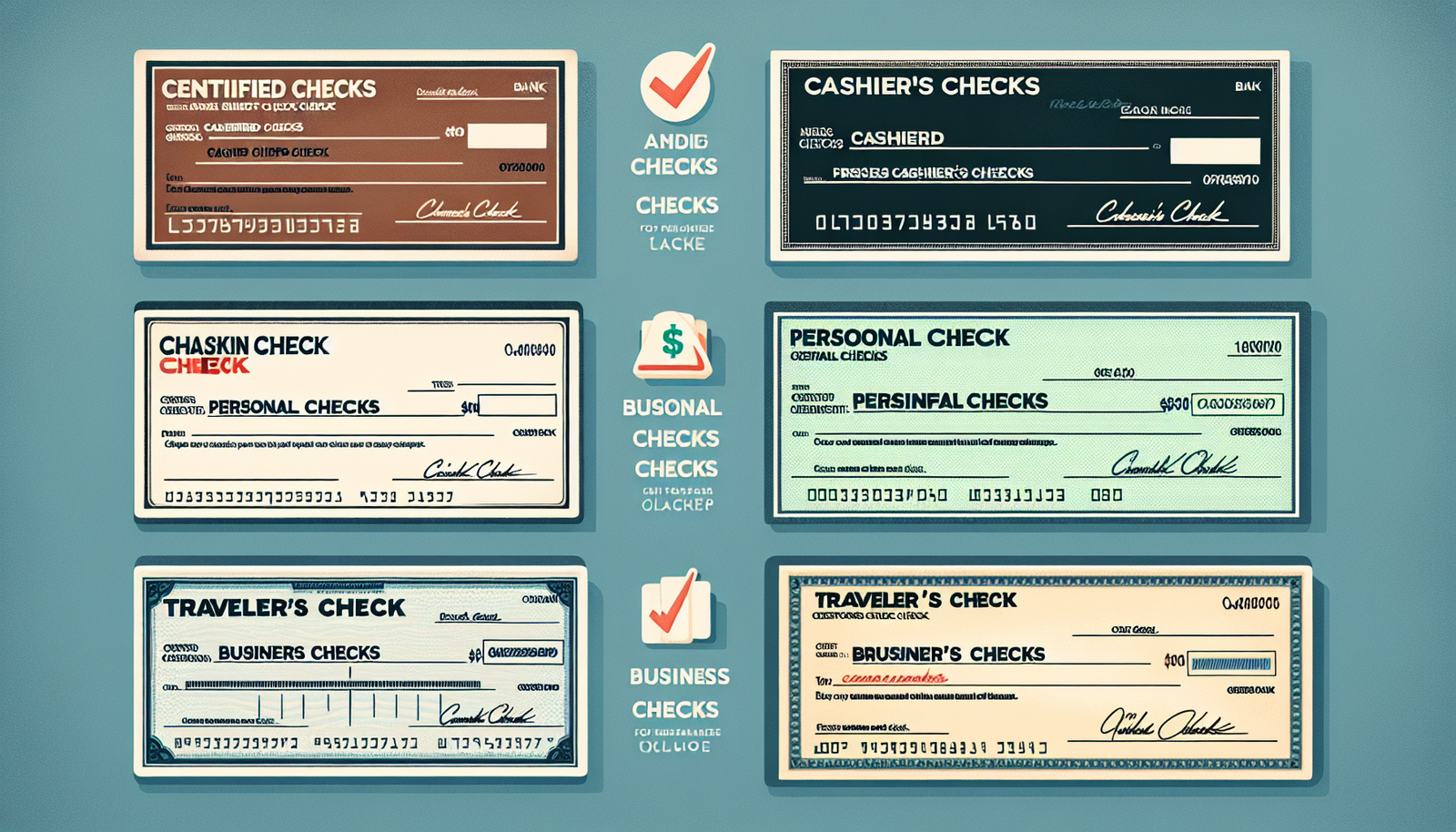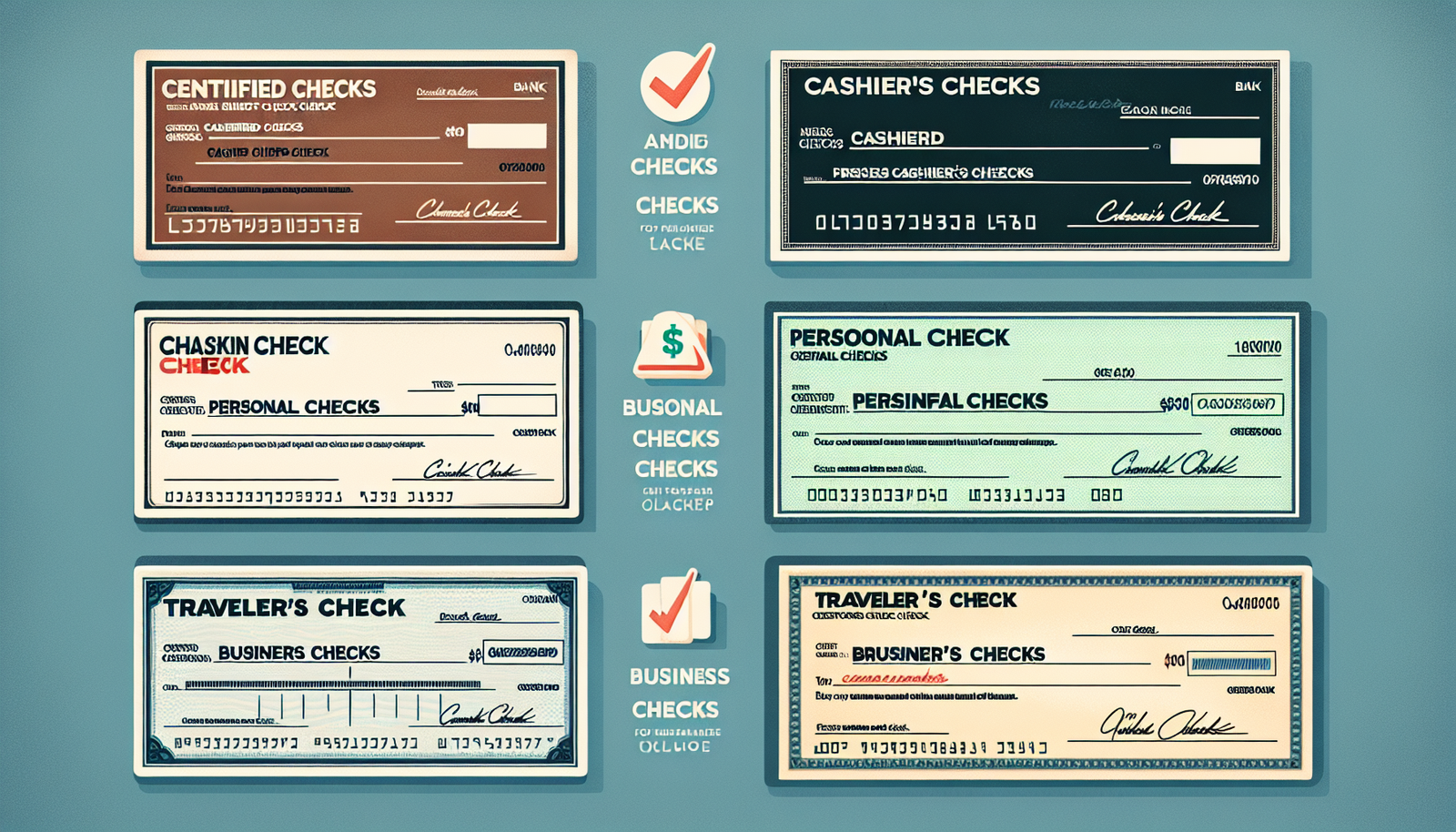
Imagine yourself stepping into a world where financial transactions become simple, flexible, and safe. Consider an world where you have control over your money movement, and even paper leaves a trail that makes fraud harder. And all this is possible through the magic of checks. In the grand theater of financial instruments, “Types of Checks” is the play you cannot miss. Brace yourself for a thrilling journey as you explore the cast of characters from personal checks and cashier’s checks to traveler’s checks, certified checks, and beyond. It’s a financial saga that will unfold right in front of your eyes, drawing back the curtain on checks in all their variety and versatility.

Personal Checks
Definition of Personal Checks
A personal check is a traditional form of payment, a slip of paper that is linked directly to your bank account. It contains sensitive information including your account number, bank routing number, your signature, and the amount of money you are planning to pay or transfer.
Use of Personal Checks
You use a personal check by writing down the details of the transaction, such as the recipient’s name, the date, and most importantly, the amount to be paid. Then you sign the check at a specific space defined for your authorization. Once the check is presented to a bank, the funds are then taken out of your account and moved to the check recipient’s account.
Benefits and Risks of Personal Checks
Personal checks have certain benefits. For example, they offer a convenient, well-documented way to pay, which can be beneficial for taxing and accounting purposes. They also provide a traceable method of payment and are considered safer than cash. However, they are not devoid of risks. Personal checks require your bank details and require trust in the recipient. There is also the risk of checks bouncing if funds are insufficient.
Cashier’s Checks
What are Cashier’s Checks
A cashier’s check, which is also known as a bank check, is a check drawn against the bank’s own funds rather than yours. They are usually required when the recipient wants to be certain that the funds are available.
Procedure for obtaining cashier’s checks
To get a cashier’s check, you need to go to the bank and provide the name of the payee, as well as the amount you need the check for. The bank will then deduct the amount from your account and issue a check.
Advantages and disadvantages of using Cashier’s Checks
The advantage of cashier’s checks is that they are considered more secure because they’re drawn on the bank’s own funds. It’s virtually guaranteed that the check won’t bounce. The downside, however, is that you might need to pay a fee to get a cashier’s check. There’s also a risk of forgery, so be sure you’re dealing with a reputable party.
Certified Checks
Understanding Certified Checks
A certified check is a type of personal check that the bank verifies and then guarantees the availability of the funds. The bank stamps the check as “certified,” indicating that the money is set aside for this check only.
Process for getting a Certified Check
To get a certified check, you are required to visit your bank physically. You’ll have to ask the bank to certify the check, the bank will then verify your account balance, and set aside the check amount in your account.
Merit and demerits of Certified Checks
The merits of certified checks include the assurance to the payee that the funds are available and secured by the bank. It reduces the risk of the check bouncing. However, the demerits include a fee for the service and necessity to visit the bank in person to get the check certified which can be time-consuming.

Money Orders
Explanation of Money Orders
A money order is a payment order issued by a bank or a post office for a specific amount of money. It’s similar to a check in form, but provides more security as it’s prepaid.
Steps taken to acquire a Money Order
To acquire a money order, one needs to visit a financial institution, post office, or some convenience stores. Then, pay for the money order and the service fee with cash, debit card, or traveler’s checks.
Pros and cons of using Money Orders
Money orders are a secure way to send cash, especially when a personal check is not an option. They can also be replaced if lost or stolen. Yet, they come with a few disadvantages: they typically come with a fee, restrict you to a certain amount limit, and are not as fast as electronic transfers.
Traveler’s Checks
Defining Traveler’s Checks
Traveler’s checks are pre-printed, fixed-amount checks that are used as a safe alternative to carrying money while traveling. They are often issued by banks and can be replaced if lost or stolen.
How to get a Traveler’s Check
To get a traveler’s check, visit your local bank and pay face value in exchange for an equivalent value of traveler’s check. Do sign them in the presence of the cashier for further security.
Perks and drawbacks of Traveler’s Checks
The perks of using traveler’s checks include safety because they can be replaced if lost or stolen. They are accepted worldwide and can be cashed at many international locations. On the other hand, the drawbacks are that fewer and fewer establishments accept them thanks to the growing popularity of credit and debit cards.
Business Checks
About Business Checks
Business checks are specially designed for business bank accounts. They usually contain the business’s name and contact information and are used to pay expenses, employees, or other costs associated with running a business.
Procedure for obtaining Business Checks
Business checks can be ordered through your bank or any online check processing service, and you can usually get them professionally printed with your business’s branding.
Advantages and disadvantages of Business Checks
The advantages of using business checks include building a professional image for your company, better management and providence of a paper trail for your accountant. However, checks can be costly to print, are vulnerable to check fraud, and may be declined or take time to clear than electronic payment methods.
Banker’s Draft Checks
Understanding Banker’s Draft Checks
A banker’s draft check is a check that ensures the payee will receive the funds because the bank guarantees payment. It’s drawn on the bank’s own funds after accepting the equivalent amount from the person requesting the draft.
Process of getting a Banker’s Draft Check
Getting a Banker’s Draft Check involves visiting your bank, transferring money from your account into the bank’s own account, and then the bank will issue you the draft check.
Pros and cons of Banker’s Draft Checks
The pros of using a banker’s draft check include guaranteed payment and increased security since it’s issued and backed up by a bank. The downside is that if you lose the check, it can be complicated or even impossible to replace.
E-Checks
Introduction to E-Checks
E-checks, or electronic checks, are a form of online payment where money is electronically withdrawn from the payer’s checking account, transferred over the ACH network, and deposited into the payee’s checking account.
Issuing an E-Check and its process
Issuing an E-Check chiefly involves inputting your banking information online during a transaction. You simply provide your bank routing number, your bank account number, and your authorization to debit the stated amount from your checking account.
Benefits and Risks involved in E-Checks
Benefits of E-checks encompass convenience and efficiency as there’s no need for traditional physical checks. However, E-checks can carry the risk of data theft if not properly secured. So, you have to trust that the receiving party has robust security measures in place.
Payroll Checks
Defining Payroll Checks
Payroll checks are checks issued by employers to pay employees for their services. It displays an employee’s net pay, gross pay, and any deductions like taxes and retirement contributions.
Process involved in obtaining Payroll Checks
Obtaining a Payroll check incorporates working for an employer. After the defined payment period, the employer issues a payroll check to each employee for the numbers of hours or the share of profits they’re entitled to.
Advantages and disadvantages of Payroll Checks
Payroll checks provide the advantage of easy record-keeping for tax purposes, but they can be a rather expensive payment method for employers due to fees associated with printing and processing checks.
Counter Checks
What are Counter Checks
Counter checks, also known as teller’s checks, are checks from an account holder who runs out of the personal check. Banks usually have these types of checks on hand and can print the customer’s account number and the bank’s routing number directly onto the check.
How to get a Counter Check
Getting a counter check is straightforward. You need to visit the counter at your bank and request a check for immediate use.
Perks and drawbacks of using Counter Checks
Counter checks offer the perk of immediacy – in case you run out of checks and need one immediately, a counter check from your bank could save the day. Nonetheless, the drawbacks include high fees for obtaining counter checks and limited acceptability because they do not carry your personal information like regular checks.

Leave a Reply